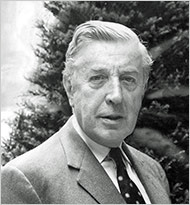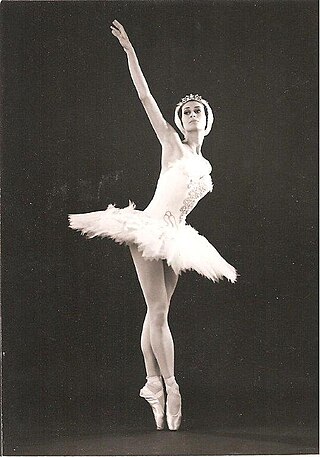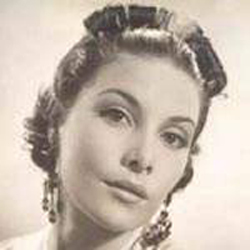Related Research Articles

Sir Robert Murray Helpmann CBE was an Australian ballet dancer, actor, director, and choreographer. After early work in Australia he moved to Britain in 1932, where he joined the Vic-Wells Ballet under its creator, Ninette de Valois. He became one of the company's leading men, partnering Alicia Markova and later Margot Fonteyn. When Frederick Ashton, the company's chief choreographer, was called up for military service in the Second World War, Helpmann took over from him while continuing as a principal dancer.

Sir Frederick William Mallandaine Ashton was a British ballet dancer and choreographer. He also worked as a director and choreographer in opera, film and revue.

Dame Margaret Evelyn de Arias DBE, known by the stage name Margot Fonteyn, was an English ballerina. She spent her entire career as a dancer with the Royal Ballet, eventually being appointed prima ballerina assoluta of the company by Queen Elizabeth II.
John Arthur Lanchbery OBE was an English-Australian composer and conductor, famous for his ballet arrangements. He served as the Principal Conductor of the Royal Ballet from 1959 to 1972, Principal Conductor of the Australian Ballet from 1972 to 1977, and Musical Director of the American Ballet Theatre from 1978 to 1980. He continued to conduct regularly for the Royal Ballet until 2001.
Maude Lloyd was a South African ballet dancer and teacher who immigrated to England and became an important figure in early British ballet as a founding member of Ballet Rambert. She had a significant second career as a dance critic, writing with her husband under the nom de plume Alexander Bland.

The Royal Ballet is a British internationally renowned classical ballet company, based at the Royal Opera House in Covent Garden, London, England. The largest of the five major ballet companies in Great Britain, the Royal Ballet was founded in 1931 by Dame Ninette de Valois. It became the resident ballet company of the Royal Opera House in 1946, and has purpose-built facilities within these premises. It was granted a royal charter in 1956, becoming recognised as Britain's flagship ballet company.
Sir Anthony James Dowell is a retired British ballet dancer and a former artistic director of the Royal Ballet. He is widely recognized as one of the great danseurs nobles of the twentieth century.
Nadia Nerina was a South African dancer who was "one of the most gifted, versatile, and inspiring ballerinas of The Royal Ballet" during the 1950s and 1960s. She was known "for her technical virtuosity, lightness afoot, effortless-seeming jumps, and joyful charm onstage, especially in comedic roles."

Leanne Faye Benjamin is a retired Australian ballet dancer who was a principal dancer with the Royal Ballet in London. She was appointed artistic director at the Queensland Ballet in 2024. She stepped down from the position on 2 August 2024.

Deanne Bergsma is a South African ballerina, who made her career in the Royal Ballet at Covent Garden. She was born in 1941 and showed early promise as a dancer, She first came to London in 1957 to take up a place in the Royal Ballet School, having been talent-spotted by Claude Newman, former principal dancer and ballet-master of the Vic-Wells Ballet and now a visiting examiner of the Royal Academy of Dance. In two years she had graduated from the school and joined the Royal Ballet company in 1957. She climbed rapidly through the ranks to become a principal ballerina and appeared in a wide array of roles, both classical and contemporary, until her retirement in 1975. This eighteen-year career coincided with an exciting period for the Royal Ballet. Apart from the stream of new works from Ashton and Macmillan the company's resident director-choreographers, it was the heyday of the partnership of Margot Fonteyn and Rudolf Nureyev. The company was touring worldwide and was rarely out of the headlines.
Maryon Lane was a South African ballet dancer who became well known in Britain as a ballerina of the Sadler's Wells Theatre Ballet and as a soloist with the Royal Ballet.
Alexander Marshall Grant was a New Zealand ballet dancer, teacher, and company director. After moving to London as a young man, he became known as "the Royal Ballet's most remarkable actor-dancer in its golden period from the 1940s to the 1960s."

Georgina Parkinson was an English ballet dancer and ballet mistress. She joined The Royal Ballet in 1957 and was promoted to principal dancer in 1962. Best known for dancing 20th-century works, she was a frequent collaborator of choreographer Kenneth MacMillan, and had also created roles for Frederick Ashton. In 1978, she accepted the invitation to become a ballet mistress at the American Ballet Theatre for a year, before assuming the position permanently in 1980. She also performed character roles with the American Ballet Theatre.

Pearl Argyle was a South African ballet dancer and actress. She appeared in leading roles with English ballet companies in the 1930s and later performed in stage musicals and in films.
William Chappell was a British dancer, ballet designer and director. He is most noted for his designs for more than 40 ballets or revues, including many of the early works of Sir Frederick Ashton and Dame Ninette de Valois.
Rhapsody is a one-act ballet choreographed by Frederick Ashton to Rachmaninoff's Rhapsody on a Theme of Paganini. The ballet was made for both Queen Elizabeth The Queen Mother's 80th birthday, and Mikhail Baryshnikov's guest appearance with the Royal Ballet. It premiered on 4 August 1980, at the Royal Opera House, with the two principal roles danced by Baryshnikov and Lesley Collier. The ballet is dedicated to the Queen Mother.
Andrée Howard, originally Louise Andréa Enriqueta Howard, was a British ballet dancer and choreographer. She created over 30 ballets.

Sarah Gilmour, was a British ballet dancer, and Ballet Rambert's "leading ballerina of the 1940s". The ODNB notes that she was "acclaimed in the 1940s as second only to Margot Fonteyn among British ballerinas".
Paula Doris Hinton was an English ballet dancer who became the wife and dancing partner of the choreographer Walter Gore.
Desmond Doyle was a South African ballet dancer who performed in England in the 1950s and 1960s before becoming ballet master of The Royal Ballet.
References
- 1 2 3 4 5 6 Clarke, Mary (31 May 1999). "Elaine Fifield". The Guardian. Retrieved 28 July 2018.
- 1 2 "Obituary: Elaine Fifield". independent.co.uk. 24 May 1999. Retrieved 28 July 2018.
- ↑ Photographs from Royal Opera House Collections Online
- ↑ English National Ballet Videos: Steps of the Ballet
- ↑ Frederick Ashton Foundation archive